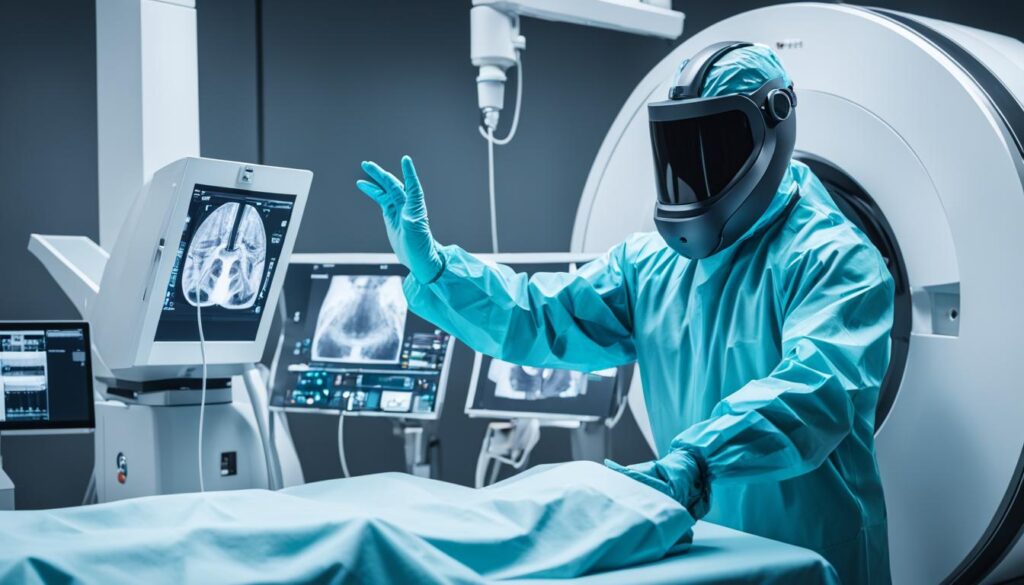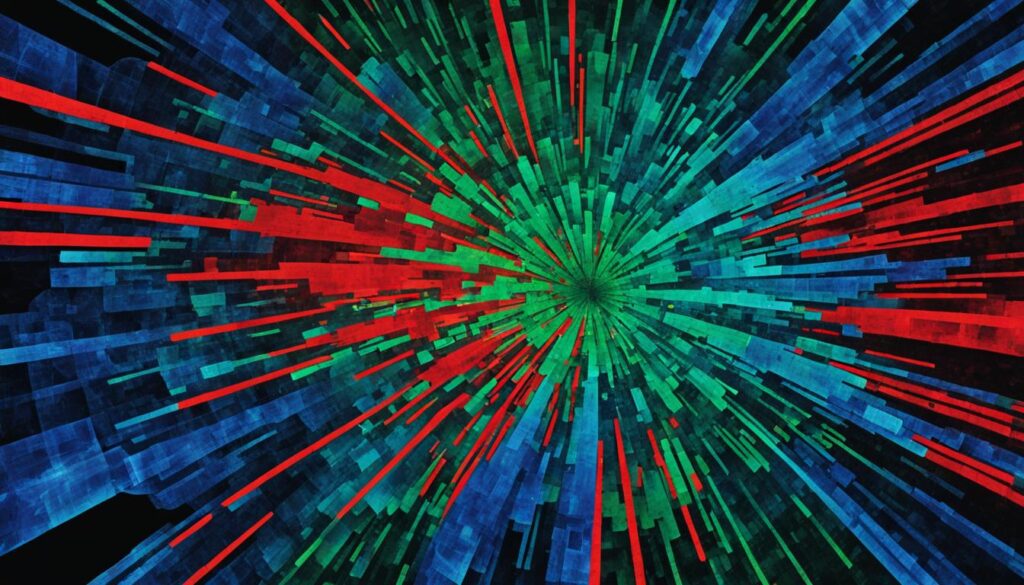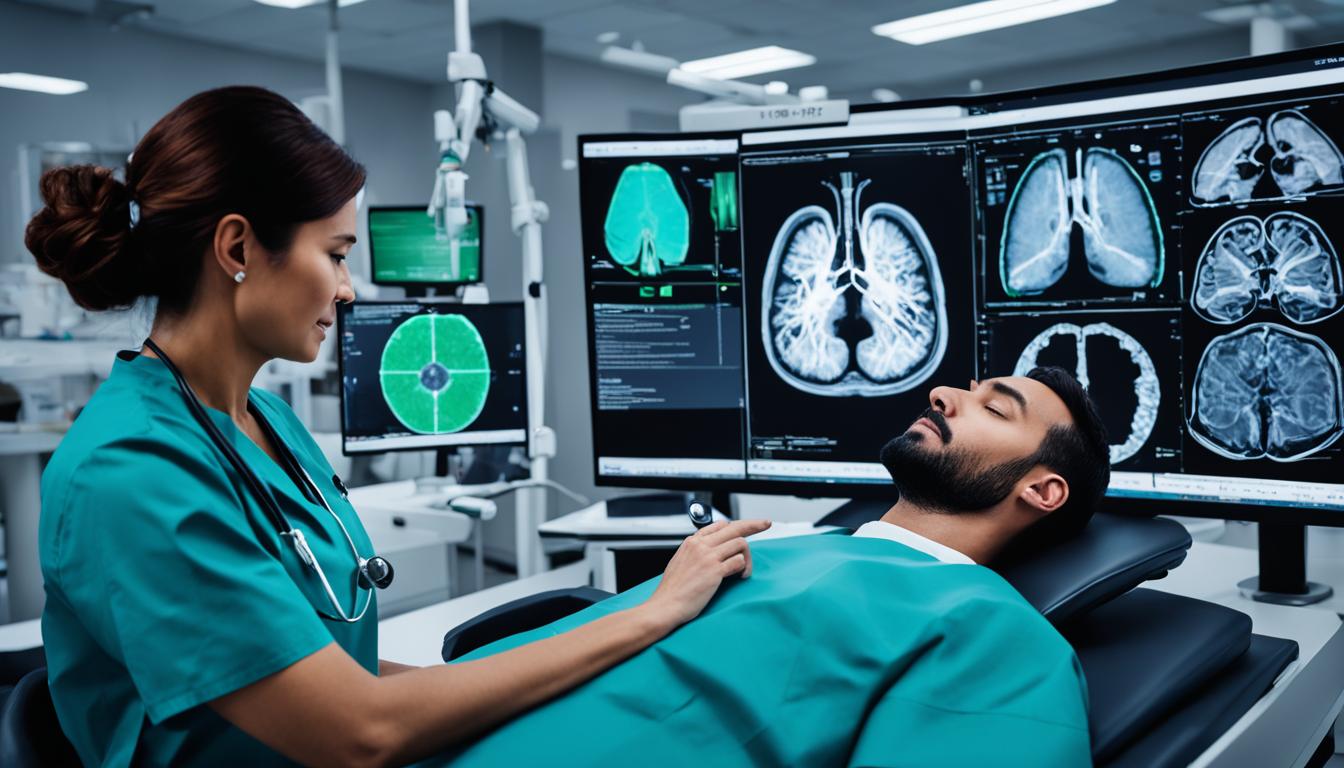Artificial intelligence (AI) has the potential to revolutionize the way we approach medical imaging and reduce radiation exposure to patients. With the use of AI technology, healthcare providers can optimize the dose of radiation delivered during imaging procedures while still maintaining high-quality results. This advancement in AI has the potential to make healthcare practices safer and minimize the risk of harmful effects from ionizing radiation.
Multiple studies have shown that AI techniques, such as deep convolutional neural networks, can effectively decrease radiation dose without compromising the diagnostic information obtained from medical images. The field of AI in radiology is still emerging, but the results so far are promising.
By harnessing the power of AI, healthcare providers can achieve dose optimization and enhance patient safety. AI algorithms can analyze and interpret medical images, allowing for more efficient diagnosis and treatment planning. Additionally, AI can assist in monitoring radiation risks relative to a patient’s age and cumulative dose, ensuring that exposure levels are kept as low as reasonably achievable.
Contents
- 1 The Importance of Radiation Dose Optimization in Pediatric Radiology
- 2 The Role of AI in Radiation Protection and Dose Optimization
- 3 The Challenges of Radiation Protection in Medical Imaging
- 4 The Role of AI in COVID-19 Diagnosis and Imaging
- 5 Conclusion
- 6 FAQ
- 6.1 Can artificial intelligence decrease radiation exposure to the patient?
- 6.2 What are the benefits of using AI to decrease patient radiation?
- 6.3 How does AI reduce patient radiation exposure?
- 6.4 What is the impact of artificial intelligence on patient radiation exposure?
- 6.5 What are the challenges in radiation protection in medical imaging?
- 6.6 How does AI assist in COVID-19 diagnosis and imaging?
- 6.7 What is the role of imaging in post-acute sequelae of COVID-19?
- 6.8 How can AI decrease radiation exposure in medical imaging?
- 7 Source Links
Key Takeaways:
- AI technology has the potential to significantly reduce radiation exposure to patients during medical imaging procedures.
- By optimizing radiation dose using AI, healthcare providers can maintain high-quality imaging results while minimizing the risks associated with ionizing radiation.
- Studies have demonstrated the effectiveness of AI techniques, such as deep convolutional neural networks, in reducing radiation dose without compromising diagnostic information.
- AI can automate the process of identifying and classifying signs of disease, improving the accuracy and efficiency of image interpretation.
- Implementing AI in medical imaging has the potential to enhance workflow management, improve image quality, and reduce errors in the diagnostic process.
The Importance of Radiation Dose Optimization in Pediatric Radiology
Pediatric patients are more vulnerable to the potential harmful effects of ionizing radiation, making radiation dose optimization particularly important in pediatric radiology. The goal is to achieve diagnostic results with the lowest possible radiation dose, while still obtaining high-quality images.
Traditionally, the dose optimization process involved adjusting exposure parameters to minimize radiation dose without compromising image quality. However, the advancement of AI techniques, such as deep convolutional neural networks, has shown great potential in further reducing radiation dose in pediatric radiology.
Studies have demonstrated that AI can reduce radiation dose by 36-70% without compromising diagnostic information. These AI models are based on deep learning image reconstruction and have shown comparable performances to commercially available models. The use of AI for dose reduction in pediatric radiology holds the promise of improving patient safety and minimizing the long-term risks associated with radiation exposure.
The Role of Deep Learning and Convolutional Neural Networks
Deep learning, a subset of machine learning, has revolutionized medical imaging by enabling complex image processing tasks. Convolutional neural networks (CNNs), a type of deep learning algorithm, have shown significant potential in reducing radiation dose while maintaining the quality of medical images.
AI has the ability to transform medical imaging by optimizing radiation dose, improving image quality, and aiding in the diagnosis of pediatric patients.
CNNs are particularly effective in medical imaging tasks due to their ability to learn and extract relevant features from large datasets. By training on vast amounts of medical images, CNNs can identify patterns and abnormalities, leading to more accurate and efficient diagnoses.
In the context of pediatric radiology, CNNs can analyze and interpret medical images with a focus on dose reduction. These AI models can process images and identify regions of interest, allowing for a reduction in radiation dose while still capturing the necessary diagnostic information.
Benefits of AI in Pediatric Radiology
The integration of AI algorithms in pediatric radiology offers several key benefits:
- Reduced radiation dose: AI techniques, such as deep learning and CNNs, have the potential to significantly lower radiation dose without compromising image quality. This is especially important to minimize the long-term risks associated with radiation exposure in pediatric patients.
- Improved image quality: By optimizing imaging parameters and reconstructing images using AI algorithms, the quality of pediatric radiology images can be enhanced, leading to more accurate interpretations and diagnoses.
- Enhanced workflow efficiency: AI can automate time-consuming tasks, such as image analysis and segmentation, allowing radiologists to focus on more complex diagnostic decisions and personalized patient care.
- Increased diagnostic accuracy: By leveraging AI algorithms, radiologists can benefit from more precise and reliable image interpretations, leading to improved diagnostic accuracy in pediatric radiology.
Overall, AI has the potential to transform medical imaging by optimizing radiation dose, improving image quality, and aiding in the diagnosis of pediatric patients. However, further research and validation are needed to fully realize the potential of AI in pediatric radiology and ensure its safe and effective implementation.
| Advantages of AI in Pediatric Radiology | Challenges of AI in Pediatric Radiology |
|---|---|
| Reduced radiation dose | Integration into existing workflow |
| Improved image quality | Validation and regulatory considerations |
| Enhanced workflow efficiency | Data privacy and security |
| Increased diagnostic accuracy | Training and education |
The Role of AI in Radiation Protection and Dose Optimization
Artificial intelligence (AI) is transforming the field of medical imaging by revolutionizing radiation protection and dose optimization. By harnessing machine learning algorithms, AI can enhance various aspects of the imaging process, including image acquisition, reconstruction and interpretation, workflow management, image quality, diagnosis, and report writing.
One of the significant benefits of AI in radiation protection is its ability to automate the identification and classification of disease signs, such as cancer, in medical images. This automation streamlines the interpretation process for radiologists, allowing them to quickly and accurately diagnose patients. With AI-powered assistance, healthcare professionals can provide more precise and efficient care.
In addition to improving diagnosis, AI can also play a crucial role in minimizing radiation risks. By estimating the risks based on a patient’s age and cumulative dose, AI algorithms help tailor the imaging procedure to ensure safety. This personalized approach reduces unnecessary radiation exposure and enhances patient well-being.
Furthermore, AI-driven automation of scanner monitoring enables the early detection of equipment maintenance issues. By promptly reporting these problems, preventive maintenance services can be improved, ensuring that imaging equipment functions optimally and minimizing any risks associated with malfunctioning machinery.
The overall impact of AI in medical imaging is a significant improvement in efficiency, accuracy, and safety. By optimizing radiation dose and image quality, AI empowers healthcare professionals to provide reliable and timely diagnoses. This technology not only enhances the diagnostic process but also reduces the radiation exposure to patients, promoting their well-being. AI is shaping the future of radiation protection and dose optimization, paving the way for safer and more advanced medical imaging practices.

The Potential of AI in Radiation Protection and Dose Optimization
The potential applications of AI in radiation protection and dose optimization extend beyond diagnosis and image interpretation. This technology holds promise in areas such as image acquisition, reconstruction, workflow management, and report writing. By leveraging AI algorithms, healthcare providers can streamline these processes, improving overall efficiency and patient outcomes.
| Application | Benefits |
|---|---|
| Image Acquisition | Automated imaging protocols based on patient characteristics, reducing unnecessary exposures. |
| Reconstruction | Dose reduction algorithms for optimized image quality. |
| Workflow Management | Automated scheduling, prioritization, and reporting, streamlining the imaging process. |
| Report Writing | AI-assisted report generation, improving accuracy and consistency. |
As AI continues to advance, healthcare providers can leverage its potential to create innovative solutions in radiation protection and dose optimization. The integration of AI algorithms in medical imaging practices has the power to reshape the field, enhancing patient care while minimizing radiation exposure risks. The future of AI in radiation protection is bright, promising safer and more efficient medical imaging procedures.
The Challenges of Radiation Protection in Medical Imaging
Ensuring radiation protection in medical imaging is essential to prevent the harmful effects of ionizing radiation on patients, healthcare workers, and the general public.
Various challenges exist in radiation protection, including the need for effective shielding to protect vital organs and body parts not under examination. Shieldings are designed to reduce the spread of radiation and minimize its impact on surrounding tissues. They act as a physical barrier between the radiation source and the individual, helping to protect against unnecessary exposure.
Time is also an important factor in radiation protection. Longer exposure times can lead to higher radiation doses, increasing the potential for harmful effects. It is crucial to minimize the time of exposure during medical imaging procedures to reduce the risk to patients and healthcare professionals.
Distance from the radiation source plays a significant role in radiation protection. As the distance increases, the level of radiation exposure decreases. Maintaining a safe distance from the radiation source is important to minimize the risks associated with ionizing radiation.
Justification is another challenge in radiation protection. It involves a risk-to-benefit analysis to ensure that the benefits of radiation exposure outweigh the potential harm. Medical imaging procedures should only be performed when the diagnostic benefits outweigh the potential risks, taking into consideration alternative non-ionizing radiation techniques.
Dose limitations are in place to ensure that individuals are not exposed to unnecessary amounts of radiation. These dose limitations are based on established guidelines and regulations to protect the health and safety of patients and healthcare workers. By adhering to dose limitations, the risks associated with radiation exposure can be minimized.
Overall, the principles of radiation protection aim to optimize radiation dose and minimize the risks associated with medical imaging procedures. By implementing effective shielding, minimizing exposure time, maintaining a safe distance, and justifying the need for imaging, healthcare providers can ensure the safety of patients and healthcare workers.
Challenges of Radiation Protection in Medical Imaging
| Challenge | Explanation |
|---|---|
| Shieldings | Protecting vital organs and body parts not under examination. |
| Time | Minimizing exposure time to reduce radiation dose. |
| Distance | Maintaining a safe distance from the radiation source. |
| Justification | Evaluating the risk-to-benefit ratio of radiation exposure. |
| Dose Limitations | Establishing guidelines to avoid unnecessary radiation exposure. |
Quote:
“Radiation protection in medical imaging is crucial to minimize the risks associated with ionizing radiation and ensure the safety of patients and healthcare workers.”
Image:

The Role of AI in COVID-19 Diagnosis and Imaging
Artificial intelligence (AI) has played a critical role in the diagnosis and imaging of COVID-19. In addition to RT-PCR testing, chest CT scans have emerged as a valuable tool for accurate COVID-19 diagnosis. AI algorithms have been developed to analyze CT images and differentiate between COVID-19 and other viral pneumonias.
Studies have shown that chest CT has a high sensitivity in detecting COVID-19, even in cases where RT-PCR tests yield false negative results. This means that chest CT can help identify COVID-19 cases that might have been missed by traditional testing methods. AI-powered algorithms enhance the interpretation of chest CT findings and improve the diagnostic accuracy, assisting healthcare professionals in making informed decisions.
It is important to note that chest CT scans should not be considered as a standalone diagnostic tool for COVID-19. Instead, they should be used in conjunction with clinical evaluation and RT-PCR testing to ensure a comprehensive and accurate diagnosis.
By leveraging AI technology, healthcare providers can harness the power of chest CT scans to enhance the detection and diagnosis of COVID-19, contributing to more effective management and control of the disease.
“AI algorithms have revolutionized the analysis of chest CT scans and improved our ability to distinguish COVID-19 from other similar conditions. The combination of AI and medical imaging holds great promise in the fight against the pandemic.”
CT Findings in COVID-19
Chest CT findings in COVID-19 patients typically include bilateral ground-glass opacities, consolidation, and traction bronchiectasis. These radiological features, among others, can provide valuable insights into the extent and severity of the disease, aiding in treatment decision-making and monitoring of patient progress.
Here is a summary of some common CT findings associated with COVID-19:
| CT Findings | Characteristic |
|---|---|
| Ground-glass Opacities | Opacity with preserved bronchial and vascular markings |
| Consolidation | Homogeneous opacity obscuring bronchial and vascular markings |
| Traction Bronchiectasis | Dilated and thickened bronchi due to fibrotic changes |
| Pleural Effusion | Fluid accumulation in the pleural space |
It’s important to note that while these findings are often associated with COVID-19, they are not exclusive to the disease and can be present in other lung conditions as well.

Image: Chest CT scan showing potential imaging abnormalities in COVID-19 long-haulers.
Persistent Symptoms in COVID-19 Long-Haulers
| Symptoms | Description |
|---|---|
| Respiratory issues | Persistent shortness of breath, cough, or chest discomfort |
| Fatigue | Excessive tiredness and lack of energy, affecting daily activities |
| Cognitive problems | Difficulty concentrating, memory issues, or brain fog |
| Heart complications | Palpitations, chest pain, or abnormal heart rhythms |
| Neurological symptoms | Headaches, dizziness, or neuropathy |
Source: Adapted from The International Journal of Clinical Practice, February 2021.
Conclusion
Artificial intelligence (AI) has revolutionized the field of medical imaging by offering a promising solution to decrease patient radiation exposure. By utilizing AI technology, healthcare providers can optimize radiation dose while maintaining high-quality diagnostic results. The benefits of using AI to reduce patient radiation are numerous, ranging from improved workflow management to enhanced image quality and diagnostic accuracy.
Studies have shown that AI algorithms, such as deep convolutional neural networks, have successfully reduced radiation dose in pediatric radiology and other imaging modalities by up to 70% without compromising diagnostic information. These advancements in AI technology provide healthcare providers with the potential to improve patient safety and minimize the risks associated with ionizing radiation.
As AI continues to evolve in the field of radiology, healthcare professionals can expect to witness significant advancements in radiation protection and dose optimization. AI solutions offer the ability to streamline image acquisition, reconstruction, and interpretation processes, reducing human error and improving efficiency. With AI, healthcare providers can also monitor equipment maintenance and automate reporting, ensuring optimal functioning of imaging devices.
In conclusion, the integration of AI in radiology presents a transformative opportunity to lower patient radiation levels. By leveraging AI technology, healthcare providers can achieve safer imaging practices, improve patient outcomes, and reduce the potential risks associated with radiation exposure. The future of AI in radiology holds great promise, bringing us closer to a paradigm where patient care and safety go hand in hand with advancements in technology.
FAQ
Can artificial intelligence decrease radiation exposure to the patient?
Yes, artificial intelligence (AI) has the potential to significantly reduce radiation exposure to patients undergoing medical imaging procedures. AI technology can optimize the dose of radiation delivered to patients while still maintaining high-quality imaging results.
What are the benefits of using AI to decrease patient radiation?
Using AI for radiation dose optimization can lead to safer practices in healthcare and a decreased risk of harmful effects from ionizing radiation. It allows healthcare providers to achieve diagnostic results with the lowest possible radiation dose, ensuring patient safety while obtaining high-quality images.
How does AI reduce patient radiation exposure?
AI techniques, such as deep convolutional neural networks, can reduce radiation dose without compromising diagnostic information. These AI models are based on deep learning image reconstruction and have shown promising results in reducing radiation dose by 36-70% in pediatric radiology studies.
What is the impact of artificial intelligence on patient radiation exposure?
The use of AI in radiology for reducing radiation exposure can revolutionize radiation protection and dose optimization in medical imaging. AI algorithms can improve workflow management, image acquisition, and interpretation, as well as optimize radiation dose and image quality. This leads to improved efficiency, reduced errors, and enhanced diagnostic processes while minimizing radiation exposure to patients.
What are the challenges in radiation protection in medical imaging?
Radiation protection in medical imaging faces challenges such as the need for effective shielding, managing exposure time, maintaining distance from the radiation source, justifying the risk-to-benefit balance, and setting dose limitations. These challenges aim to optimize radiation dose and minimize the risks associated with medical imaging procedures.
How does AI assist in COVID-19 diagnosis and imaging?
AI algorithms have been developed to analyze chest CT images and assist in differentiating COVID-19 from other viral pneumonias. The use of AI in CT interpretation can improve the accuracy of COVID-19 diagnosis, especially in cases where RT-PCR tests yield false negative results. It is important to note that CT scans should not be considered as a standalone diagnostic tool but as a supplement to clinical evaluation and RT-PCR testing.
What is the role of imaging in post-acute sequelae of COVID-19?
Imaging, particularly chest CT scans, plays a crucial role in assessing and managing the long-term effects of COVID-19, known as post-acute sequelae or “long COVID.” CT follow-up allows for the detection of imaging abnormalities and helps guide further treatment and management strategies in patients with persistent symptoms or lung abnormalities.
How can AI decrease radiation exposure in medical imaging?
By utilizing AI algorithms, medical imaging practices can optimize radiation dose, improve workflow management, interpretation, and image quality, leading to safer practices and decreased radiation exposure for patients.




